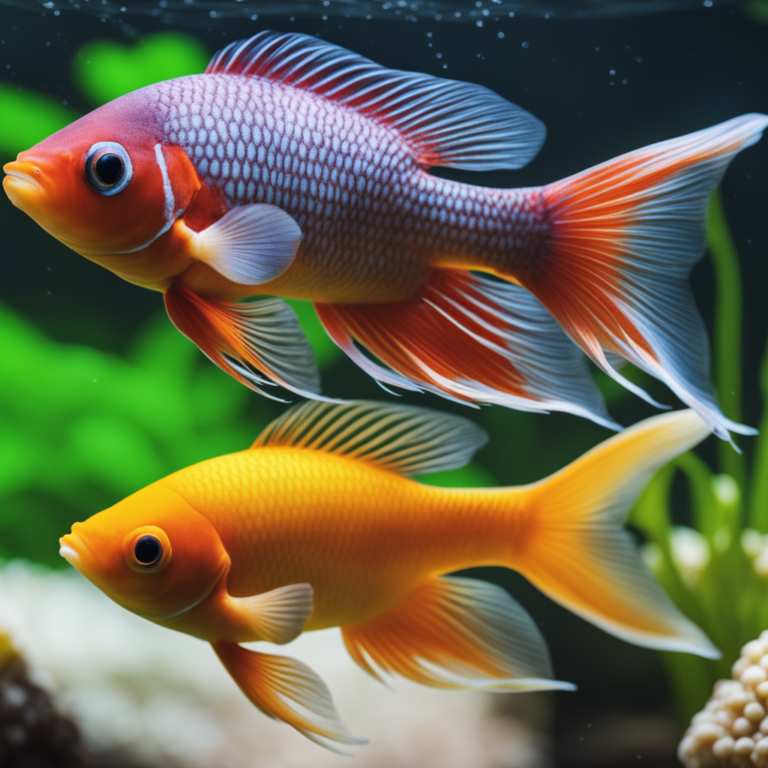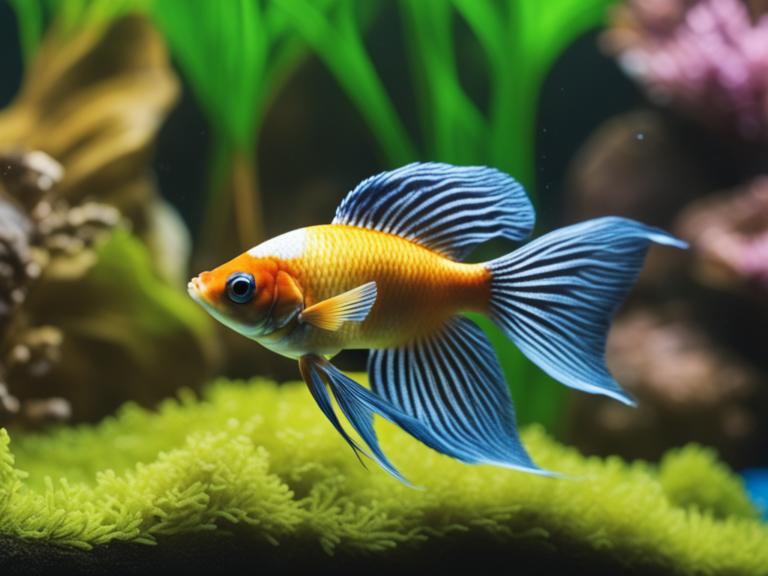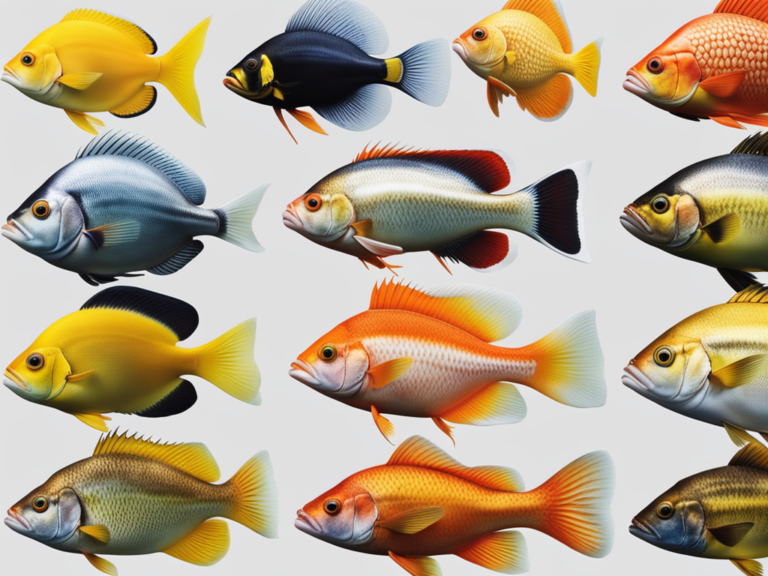Most Resilient Pet Fish Breeds

Have you ever wondered if some fish breeds are more resilient than others? Well, the theory suggests that certain pet fish breeds possess a higher level of resilience than others. In this article, we will explore the most resilient pet fish breeds that can thrive in various conditions and withstand different challenges.
From the popular Goldfish to the vibrant Betta Fish, these breeds have proven their ability to adapt and survive in different aquarium environments. Additionally, the Guppy, Swordtail, Zebrafish, and White Cloud Mountain Minnow are also known for their resilience and ability to endure changes in water conditions. So, if you’re looking for a pet fish that can handle a few bumps in the road, keep reading to discover the most resilient breeds.
Goldfish
If you’re looking for a low-maintenance pet fish that can withstand various water conditions, goldfish are your best bet. Goldfish are one of the most popular freshwater fish species kept as pets due to their hardiness and adaptability. In this section, we will provide you with some essential goldfish care tips and goldfish breeding techniques.
When it comes to goldfish care, maintaining a suitable environment is crucial. Goldfish thrive in a spacious tank with a minimum capacity of 20 gallons per fish, as they produce a significant amount of waste. Ensure the tank has adequate filtration and aeration to keep the water clean and oxygenated. It’s important to monitor water parameters regularly, including temperature, pH level, and ammonia levels, and make adjustments as needed. Additionally, goldfish prefer a diet rich in plant matter, such as commercial pellet or flake food, supplemented with fresh vegetables like peas or lettuce.
Breeding goldfish can be a rewarding experience, but it requires careful planning and preparation. To encourage breeding, provide your goldfish with a separate breeding tank or a well-decorated section within the main tank. Maintain a water temperature of around 68-74°F and gradually increase it to stimulate spawning. It’s essential to closely monitor the water quality, ensuring it is free from pollutants and maintaining ideal pH levels. To enhance breeding success, you can introduce live plants or spawning mops as potential spawning sites. Once the eggs are laid, transfer them to a separate hatching tank, keeping a close eye on water conditions and providing appropriate food for the fry.
Betta Fish
Betta fish are a popular choice for pet owners seeking a vibrant and resilient aquatic companion. These colorful and active fish are known for their unique personalities and ability to thrive in various environments. If you’re considering bringing a betta fish into your home, here are some care tips and tank setups to ensure their well-being:
- Tank Size: Betta fish require a minimum tank size of 2.5 gallons, but a larger tank is always better. This allows them to have ample space to swim and explore.
- Water Temperature: Betta fish are tropical fish and prefer their water to be kept between 78-80°F (25-27°C). Using a reliable aquarium heater is essential for maintaining a consistent temperature.
- Water Quality: Regular water changes are crucial to keep the water clean and free from harmful toxins. Aim for weekly water changes of 25-50% to ensure optimum water quality.
- Tank Decor: Providing your betta fish with hiding spots and plants not only enhances the aesthetics of the tank but also mimics their natural habitat. Live or silk plants are recommended to prevent bettas from tearing their delicate fins.
- Tank Mates: While betta fish are known for their aggressive nature, they can coexist with certain tank mates. Avoid keeping them with other aggressive or fin-nipping fish. Peaceful species like snails or shrimp can make suitable companions.
Guppy
When considering another resilient pet fish breed to add to your collection, look no further than the guppy. Guppies, scientifically known as Poecilia reticulata, are not only hardy but also come in a wide range of color variations, making them a popular choice among fish enthusiasts.
Guppies are known for their unique breeding patterns. They are livebearers, which means that they give birth to live young rather than laying eggs. Female guppies are capable of reproducing multiple times from a single mating, resulting in a continuous cycle of breeding. This prolific breeding ability has led to various color variations within the guppy population.
Color variations in guppies are a result of selective breeding. Breeders have focused on developing different color patterns, including solid colors, metallics, and even iridescents. Some guppies display vibrant hues of red, orange, yellow, blue, and green, while others exhibit intricate patterns and markings. These color variations have made guppies a favorite choice for aquarists looking to add a splash of color to their tanks.
In addition to their striking appearance, guppies are also known for their adaptability to different water conditions. They can tolerate a wide range of temperatures and pH levels, making them suitable for both beginner and experienced fish keepers. Guppies are also highly adaptable to various diets, including flake food, frozen food, and even live food.
When it comes to resilience, breeding patterns, and color variations, guppies are an excellent choice for any fish enthusiast. Their hardiness, coupled with their vibrant colors and interesting breeding habits, make them an attractive addition to any aquarium. So, if you are looking for a resilient pet fish breed, consider adding guppies to your collection.
Swordtail
To continue exploring resilient pet fish breeds, consider adding the swordtail to your collection. Swordtails (Xiphophorus hellerii) are a popular choice for aquarium enthusiasts due to their vibrant colors, ease of care, and interesting breeding habits. Here are some key points to consider when caring for swordtails:
- Breeding Habits: Swordtails are livebearers, which means they give birth to live young instead of laying eggs. Male swordtails have a distinct elongated lower fin called a “sword,” hence their name. Breeding swordtails is relatively easy, as they are prolific breeders. Provide a separate breeding tank with dense vegetation for the female to hide and give birth. After mating, the female can produce multiple batches of fry without the need for a male.
- Tank Requirements: Swordtails require a spacious tank to thrive. Aim for a minimum tank size of 20 gallons for a small group of swordtails. They are active swimmers, so provide plenty of open space for them to explore. Swordtails prefer a well-filtered tank with regular water changes to maintain good water quality. Maintain a temperature between 72-82°F (22-28°C) and a pH level of 6.8-8.0.
- Diet: Swordtails are omnivorous and will eat a variety of foods. A balanced diet should include high-quality flake or pellet food supplemented with frozen or live foods like brine shrimp, daphnia, or bloodworms. Feed them small amounts multiple times a day to prevent overfeeding and maintain good health.
- Tankmates: Swordtails are generally peaceful fish and can coexist with other peaceful community fish. Avoid keeping them with aggressive or fin-nipping species. Good tankmates include tetras, mollies, platies, and peaceful bottom-dwelling fish like Corydoras catfish.
- Water Parameters: Swordtails prefer slightly hard water with a moderate to high level of dissolved minerals. Regularly test and maintain appropriate water parameters to ensure the health and well-being of your swordtails.
Zebrafish
For those looking to expand their collection of resilient pet fish breeds, consider adding zebrafish to your aquarium. Zebrafish (Danio rerio) have gained popularity not only as pets but also as valuable model organisms in biomedical research. Their unique advantages make them a fascinating choice for studying development and regeneration.
Zebrafish possess several characteristics that make them ideal for scientific research. Firstly, they have a rapid generation time, with a complete life cycle that lasts only three to four months. This allows researchers to study multiple generations in a relatively short period of time, accelerating the pace of scientific discoveries. Additionally, their embryos are transparent, allowing researchers to observe their development in real-time. This transparency is particularly advantageous for studying embryogenesis and organ development, as it provides a clear view of internal structures.
Furthermore, zebrafish exhibit remarkable regenerative abilities. They can regenerate various tissues, including their heart, spinal cord, and fins. This regenerative capacity makes them a valuable model for studying tissue repair and regeneration in humans. By understanding the underlying mechanisms of zebrafish regeneration, scientists hope to develop new therapies for treating injuries and diseases in humans.
Zebrafish also share a high degree of genetic similarity with humans. Approximately 70% of human genes have zebrafish counterparts, making them an excellent model for studying human diseases. Researchers can introduce genetic mutations in zebrafish to mimic human genetic disorders and investigate potential treatments.
White Cloud Mountain Minnow
One resilient pet fish breed you should consider adding to your collection is the White Cloud Mountain Minnow. This small, freshwater fish is native to the White Cloud Mountain region in China and has become a popular choice for aquarium enthusiasts. Here are five key aspects of the White Cloud Mountain Minnow that make it a resilient and fascinating pet fish:
- Habitat requirements: The White Cloud Mountain Minnow thrives in well-maintained aquariums with a temperature range of 64-72°F (18-22°C). They prefer a pH level between 6.0 and 8.0 and require a tank with plenty of plants and hiding places. These fish are known to be adaptable to various water conditions, making them relatively easy to care for.
- Breeding habits: The White Cloud Mountain Minnow is a prolific breeder and can reproduce in both aquarium and pond settings. They are egg scatterers, meaning they lay their eggs among plants or on the aquarium substrate. To promote breeding, provide a separate breeding tank with fine-leaved plants and a temperature of around 72-75°F (22-24°C). The eggs typically hatch within 48 hours, and the fry can be fed with infusoria or commercially available fry food.
- Social behavior: White Cloud Mountain Minnows are peaceful fish that can be kept in a community tank with other non-aggressive species. They are known for their playful and active behavior, often seen swimming in groups. However, it is important to provide enough space and hiding spots to prevent any territorial disputes.
- Diet: These fish are omnivorous and have a varied diet. They will readily accept commercial flakes or pellets, but it is essential to supplement their diet with live or frozen foods such as brine shrimp, daphnia, or bloodworms. A balanced diet will ensure their health and vibrant colors.
- Hardiness: The White Cloud Mountain Minnow is highly adaptable and can tolerate a wide range of water conditions. They are known for their resilience and ability to withstand fluctuations in temperature and pH levels. This makes them an excellent choice for beginner aquarists or those looking for low-maintenance fish.
The White Cloud Mountain Minnow is a resilient and visually appealing fish that can bring life and color to your aquarium. With its adaptable nature, interesting breeding habits, and peaceful demeanor, it is no wonder why this species has become a favorite among fishkeepers.
Frequently Asked Questions
Do All Goldfish Have the Same Lifespan or Are Some Breeds More Long-Lived Than Others?
Goldfish breeds can vary in lifespan due to factors like genetics, care, and breeding techniques. Factors affecting their lifespan include water quality, diet, tank size, and overall health. Some breeds may be more long-lived than others.
Can Betta Fish Be Kept in a Community Tank With Other Fish Species?
Betta fish are not typically compatible with other fish species in a community tank. They are known for their aggressive nature and territorial behavior, making it difficult for them to coexist peacefully with tankmates.
Are Guppies Suitable for Beginners or Do They Require More Advanced Care?
Guppies are suitable for beginners due to their low maintenance needs. However, they can thrive with more advanced care, such as providing a well-balanced diet and maintaining proper water conditions.
What Is the Average Size of a Fully Grown Swordtail Fish?
The average size of a fully grown swordtail fish is around 3-4 inches. They have a moderate growth rate, reaching their adult size within a few months. Swordtails make resilient and adaptable pets for fish enthusiasts.
Do Zebrafish Require Any Special Water Conditions or Can They Adapt to a Wide Range of Environments?
Zebrafish have unique requirements when it comes to water conditions. They prefer a temperature range of 78-82°F and a pH level of 6.5-7.5. However, they are adaptable and can thrive in a wide range of environments, making them suitable for community tanks.
Most Resilient Pet Fish Breeds Conclusion
When it comes to choosing a resilient pet fish breed, there are several options to consider. Goldfish, Betta Fish, Guppy, Swordtail, Zebrafish, and White Cloud Mountain Minnow have all proven to be hardy and adaptable in various aquarium environments. These fish possess the ability to withstand fluctuations in water conditions, temperature, and other factors, making them suitable options for beginner fishkeepers or those seeking low-maintenance pets. It is important to provide proper care and attention to ensure the well-being and longevity of any pet fish.








